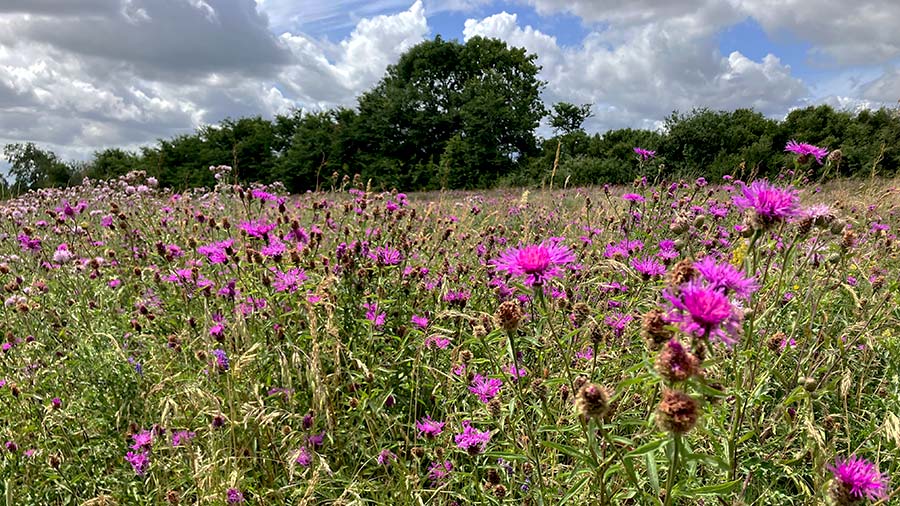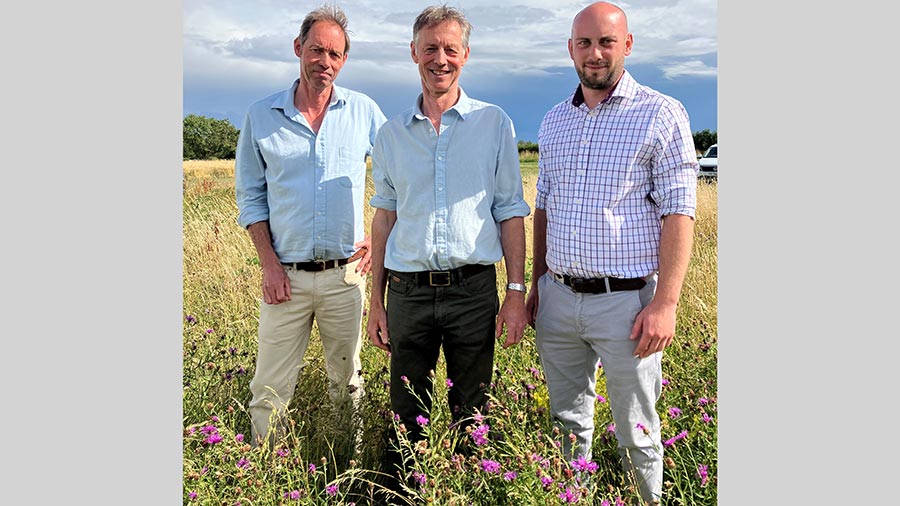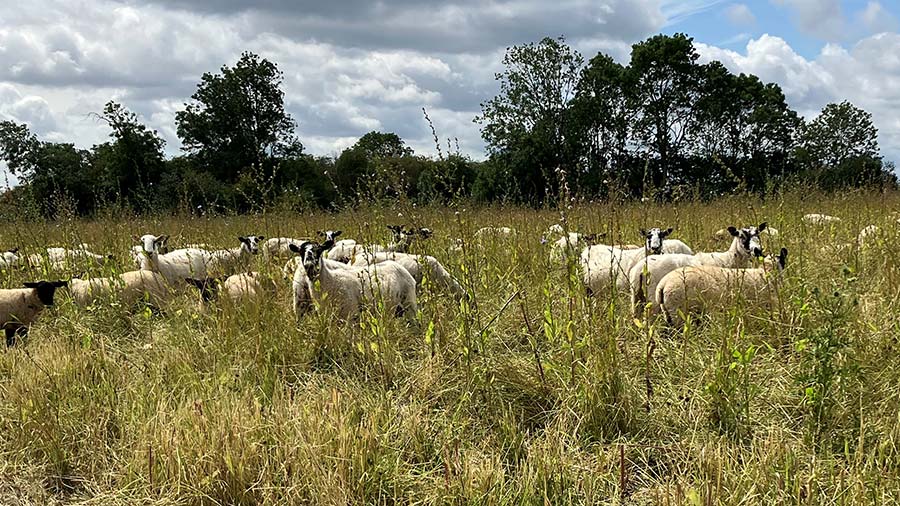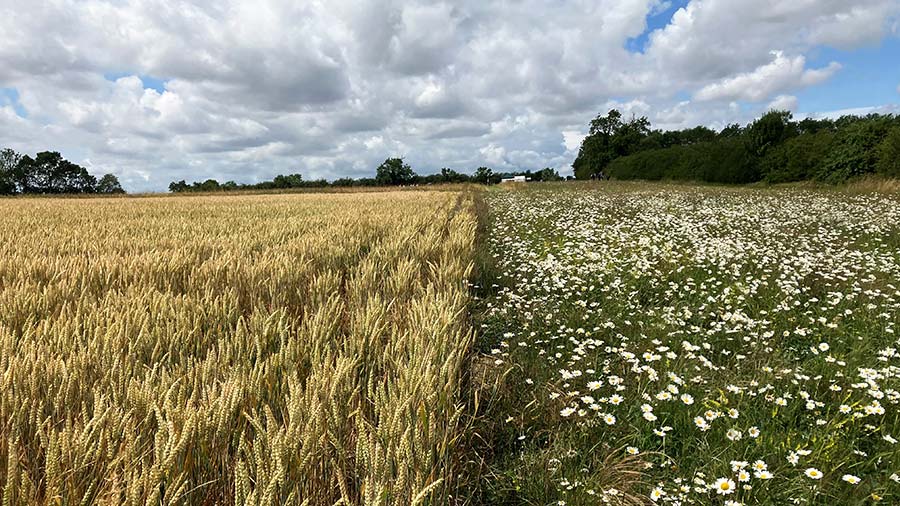Five-year farm trial aims to find ultimate soil rejuvenator
 Habitat creation is a key focus at The Grange Farm © MAG/Emma Gillbard
Habitat creation is a key focus at The Grange Farm © MAG/Emma Gillbard For farming duo William and Andrew Pitts, a five-year trial hopes to pin-point a sustainable farming system which promotes food production, soil health and biodiversity.
On a quest to find the ultimate soil rejuvenator, “Project fortress” aims to investigate a number of strategies which improve soils, provide pollinator habitats and store carbon.
Being put to the test is a herbal ley grazed by sheep, a one- and two-year “supercharger” cover crop, flower headlands and agrofloristry strips.
See also: Plasma-treated slurry reveals promising results in trials

William and Andrew Pitts and farm manager Jack McGrath © MAG/Emma Gillbard
The trial
Habitat creation has always been a key focus for the Northamptonshire brothers which is why they dedicate 14% of their 800ha arable farm to Higher Level Stewardship (HLS).
William and Andrew now plan to take their ecological farming one step further.
The soil rejuvenation trial is in its second year and is set up in partnership with crop protection manufacturer BASF as part of the company’s climate-smart farming initiative.
Like many fields in the UK, “Fortress field” at The Grange Farm near Wellingborough had reached a yield plateau after decades of intensive rotations of wheat and oilseed rape.
Independent soil scientist Prof Jenni Dungait carried out initial soil assessments on the 12.5ha Hanslope clay field.
She discovered well-structured soil aggregates with worm casts in the top 15cm, but deeper down the profile, analysis revealed a compacted soil layer with more angular aggregates.
Running a min-till operation for seven years has greatly improved soil structure and organic matter levels at The Grange.
In fact, organic matter levels have risen from 3 to 7%. However, the next aim for the brothers is to improve health deeper down the soil profile and alleviate the compaction layer at depth.
Herbal leys and sheep grazing

The local shepherd’s 60-sheep flock graze the herbal leys © MAG/Emma Gillbard
As part of the trial, a 21-way herbal ley mix was established. Working closely with farm manager Jack McGrath, the three- and four-year herbal ley is being grazed by 60 of the local shepherd’s sheep.
The Grange Farm was previously a 200-herd dairy farm, but 20 years ago the brothers transitioned it into a full-scale arable operation after crumbling dairy prices left the pair questioning the farm’s future.
Bringing livestock back onto the farm is, therefore, of particular interest.
“With seven species of clover, seven herbs and seven grasses, the aim is to eat one-third, leave one-third and trample one-third.
“The crops do not lose a lot of root and shoot mass so they recover quickly,” says William.
This enables a zero-population blackgrass reset, soil structure improvements due to the wide range of species, and nutrient cycling via the sheep.
The plan is to spray off half of the herbal ley and plant to winter wheat in autumn 2023, with the remaining 50% planted to wheat in 2024.
Supercharger cover crops
The benefits of cover cropping are generally well known, but their ability to enhance yield potential associated with the length of time spent in the ground is less understood.
Diverse one- and two-year supercharger cover crop mixes were planted to assess the impact on a following crop of winter wheat.
William and Andrew hope to identify whether the positive effects of cover crops on soil health and carbon increase the longer they are left in the ground.
As most of the land is rented, William says taking land out of production has to pay via an increase in yield of forthcoming wheat crops, enhanced by Sustainable Farming Incentive (SFI) cover crop funding.
“Who rents a field and doesn’t grow anything on it? That’s why we’re hoping SFI will be able to fund this,” he says.
William expects a 20% wheat yield uplift and a 10% increase in the second year, with improved blackgrass control.
The cover is now in its second year of growth and has a huge amount of biomass, up to 2m in height.
“The difference in size has been unbelievable, with deep tap roots breaking up the layers of compaction identified deep in the soil profile.”
Mike Green, BASF agricultural sustainability manager, explains the plan is to spray the two-year cover off and direct-drill right into it with a John Deere 750A.
“We will let the crop lie flat on the surface, while the roots remain connected in the ground. This will provide a source of carbon and nutrients which gradually breaks down over the next six-to-eight months.
“This also provides an excellent source of bird food and habitat for a range of insects,” he says.
Flower headlands

Flower turning headlands at The Grange Farm © MAG/Emma Gillbard
Meadow flower turning headlands have also been established at two opposite sides of the trial field.
Previously underproductive and compacted headlands are now delivering habitat for farmland pollinators with soil rejuvenation benefits.
This improves efficiency of machinery passes, with faster in/out traffic between tramline turns.
Once soil health has improved, after about four years, the headlands can be returned to the crop system and new headlands created in other, poorer areas.
Alternatively, the pollinator and carbon value of these habitats could meet the requirements of biodiversity net gain schemes and carbon offsets.
Furthermore, all plots are divided by an 8m agroflorestry margin, comprising two flower margins with a 2m undisturbed tussocky grass running through the middle.
This embeds meadow areas into productive arable land, delivering a place for beneficial insects to feed and breed.
Next steps
The plan over the next four years is to continue to track soil health benefits including organic matter, soil carbon and bulk density.
Equally important will be assessing the economic viability of the cropping options with the help of farm business consultants.

